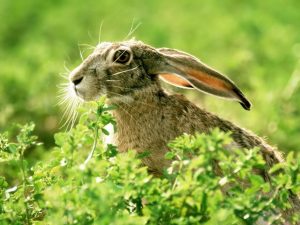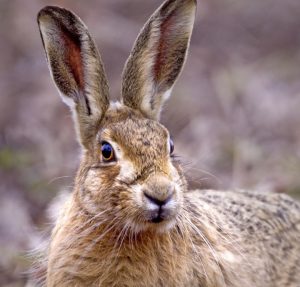 A magical, mysterious, beautiful and elusive creature. Often seen in the distance but once spotted always sprinting away out of sight to safer ground.
A magical, mysterious, beautiful and elusive creature. Often seen in the distance but once spotted always sprinting away out of sight to safer ground.
Hares have always been around mankind since his beginnings. The species of hare that now inhabits Europe have been here since the beginning of late Pleistocene epoch, about 100 000 years.
They feature in many cultures worldwide from as far afield as China to the America’s. Chinese and Indian mythology often refers not to the man in the moon but the hare in the moon. Old spiritual beliefs of American Indians often saw their long lost relatives reincarnated as hares.
In Britain, the hare was associated with the Anglo Saxon goddess Eostre, whose pagan attributes were appropriated into the Christian tradition as the Easter Bunny. The hare also appears throughout English folklore and in common speech with sayings such as “as mad as a March hare”. The legend of the White Hare tells of a witch who takes the form of a white hare and goes out looking for prey at night or of the spirit of a broken-hearted maiden who cannot rest and who haunts her unfaithful lover. In some of these stories, the characters who harm hares often suffer dreadful consequences.
Hares belong to the Lepridae family. A young hare is called a leveret.
Hares and rabbits are very different; a hare’s heart is very large in relation to its body size in comparison to that of a rabbit, also the volume of blood per body size is much larger in the hare. The large heart and greater volume of blood combined with long strong hind legs give the hare exceptional speed and endurance.

Rabbits however being born hairless, blind and deaf are completely helpless for the first few weeks after birth. They also snuggle together when first born within a deep cosy burrow which makes them less of a solitary creature. The hare’s lonely start to life probably encourages its on-going independence.The hare relies on camouflage first and speed second for protection, often keeping completely still in its form until the very last minute as danger approaches.
Hares are very fast-moving animals; the brown hare is able to run at speeds of up to 45 mph. They live solitarily or in pairs. Normally a shy animal, the brown hare changes its behaviour in spring, when hares can be seen in broad daylight chasing one another around meadows; this appears to be competition between males to attain dominance (and hence more access to breeding females). During this spring frenzy, hares can be seen “boxing”; one hare striking another with its paws (probably the origin of the term “mad as a March hare”).
The hare population has been in serious decline over the last few decades. Once a creature that was a very familiar sight in the countryside, has now become a rarity.
Many factors have spelt this decline including modern industrialised crop production with large machines and the intense use of chemicals. As hares and their young are very reluctant to move when threatened, modern large crop harvesting machinery has a tendency to massacre them. The use of chemicals and the singularity of modern crops achieve a lack of plant biodiversity and therefore a shortage of food stuffs for the hare.
This combined with no protection from a closed season (no hunting/killing in the breeding season) in England enables a perfect set of circumstances to eradicate the hare from our countryside.
Let’s not lose this iconic creature from our midst.
Please write to your M.P. (use the link below) and help save a piece of your past, present and future. Save the hare.
www.hsi.org/issues/hare_protection/
